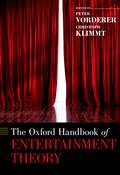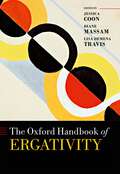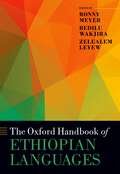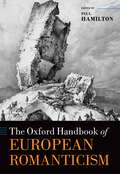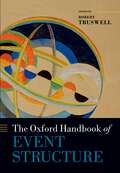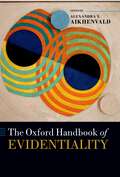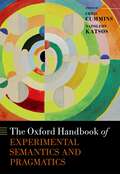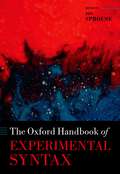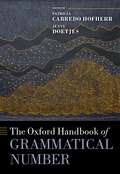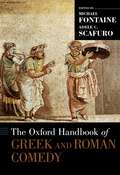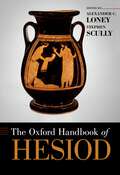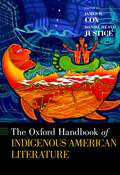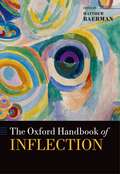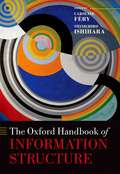- Table View
- List View
The Oxford Handbook of Entertainment Theory (Oxford Handbooks)
The proliferation of new digital technologies has given rise to an entirely changed media landscape and revolutionized how we seek entertainment. Older entertainment media like novels, radio, and film have been joined by a host of digital media that smartphones allow us to carry almost anywhere and at all times, from video games and social media to video on demand services. This unprecedented ubiquity of entertainment media calls for new and more sophisticated theories that help us understand the fascination that different entertainment media exert on us and how they change the human experience. The Oxford Handbook of Entertainment Theory surveys and furthers the most influential psychology-driven research on media entertainment to illuminate how people are drawn into media experiences. The 41 chapters in this Handbook not only offer fresh perspectives on established theories but also introduce emerging models and highlight the importance of considering the diverse backgrounds of media users when conducting research. They also cover the motivations and reactions of media users in relationship to different types of media, the trend towards interactive media such as video games and virtual reality, and particularly popular media contents like sexuality, violence, sports, and the news. As the most comprehensive overview of psychology-based research on media entertainment available, this Handbook is an invaluable resource for seasoned researchers and those beginning to learn about the field alike.
The Oxford Handbook of Ergativity (Oxford Handbooks)
by Jessica Coon, Diane Massam, and Lisa Demena TravisThis volume offers theoretical and descriptive perspectives on the issues pertaining to ergativity, a grammatical patterning whereby direct objects are in some way treated like intransitive subjects, to the exclusion of transitive subjects. This pattern differs markedly from nominative/accusative marking whereby transitive and intransitive subjects are treated as one grammatical class, to the exclusion of direct objects. While ergativity is sometimes referred to as a typological characteristic of languages, research on the phenomenon has shown that languages do not fall clearly into one category or the other and that ergative characteristics are not consistent across languages. Chapters in this volume look at approaches to ergativity within generative, typological, and functional paradigms, as well as approaches to the core morphosyntactic building blocks of an ergative construction; related constructions such as the anti-passive; related properties such as split ergativity and word order; and extensions and permutations of ergativity, including nominalizations and voice systems. The volume also includes results from experimental investigations of ergativity, a relatively new area of research. A wide variety of languages are represented, both in the theoretical chapters and in the 16 case studies that are more descriptive in nature, attesting to both the pervasiveness and diversity of ergative patterns.
The Oxford Handbook of Ergativity (Oxford Handbooks)
This volume offers theoretical and descriptive perspectives on the issues pertaining to ergativity, a grammatical patterning whereby direct objects are in some way treated like intransitive subjects, to the exclusion of transitive subjects. This pattern differs markedly from nominative/accusative marking whereby transitive and intransitive subjects are treated as one grammatical class, to the exclusion of direct objects. While ergativity is sometimes referred to as a typological characteristic of languages, research on the phenomenon has shown that languages do not fall clearly into one category or the other and that ergative characteristics are not consistent across languages. Chapters in this volume look at approaches to ergativity within generative, typological, and functional paradigms, as well as approaches to the core morphosyntactic building blocks of an ergative construction; related constructions such as the anti-passive; related properties such as split ergativity and word order; and extensions and permutations of ergativity, including nominalizations and voice systems. The volume also includes results from experimental investigations of ergativity, a relatively new area of research. A wide variety of languages are represented, both in the theoretical chapters and in the 16 case studies that are more descriptive in nature, attesting to both the pervasiveness and diversity of ergative patterns.
The Oxford Handbook of Ethiopian Languages (Oxford Handbooks)
by Ronny Meyer, Bedilu Wakjira, Zelealem LeyewThis handbook provides a comprehensive account of the languages spoken in Ethiopia, exploring both their structures and features and their function and use in society. The first part of the volume provides background and general information relating to Ethiopian languages, including their demographic distribution and classification, language policy, scripts and writing, and language endangerment. Subsequent parts are dedicated to the four major language families in Ethiopia - Cushitic, Ethiosemitic, Nilo-Saharan, and Omotic - and contain studies of individual languages, with an initial introductory overview chapter in each part. Both major and less-documented languages are included, ranging from Amharic and Oromo to Zay, Gawwada, and Yemsa. The final part explores languages that are outside of those four families, namely Ethiopian Sign Language, Ethiopian English, and Arabic. With its international team of senior researchers and junior scholars, The Oxford Handbook of Ethiopian Languages will appeal to anyone interested in the languages of the region and in African linguistics more broadly.
The Oxford Handbook of Ethiopian Languages (Oxford Handbooks)
This handbook provides a comprehensive account of the languages spoken in Ethiopia, exploring both their structures and features and their function and use in society. The first part of the volume provides background and general information relating to Ethiopian languages, including their demographic distribution and classification, language policy, scripts and writing, and language endangerment. Subsequent parts are dedicated to the four major language families in Ethiopia - Cushitic, Ethiosemitic, Nilo-Saharan, and Omotic - and contain studies of individual languages, with an initial introductory overview chapter in each part. Both major and less-documented languages are included, ranging from Amharic and Oromo to Zay, Gawwada, and Yemsa. The final part explores languages that are outside of those four families, namely Ethiopian Sign Language, Ethiopian English, and Arabic. With its international team of senior researchers and junior scholars, The Oxford Handbook of Ethiopian Languages will appeal to anyone interested in the languages of the region and in African linguistics more broadly.
The Oxford Handbook of European Romanticism (Oxford Handbooks)
by Paul HamiltonTThe Oxford Handbook to European Romanticism brings together leading scholars in the field to examine the intellectual, literary, philosophical, and political elements of European Romanticism. The book focuses on the cultural history of the period extending from the French Revolution to the uprisings of 1848. It begins with a series of chapters examining key texts written by major writers in languages including: French; German; Italian; Spanish; Russian; Hungarian; Greek; and Polish amongst others. A second section then explores the naturally inter-disciplinary quality of Romanticism, exemplified by the different discourses with which writers of the time set up an internal, comparative dynamic. These chapters highlight the sense a discourse gives of being written knowledgeably against other pretenders to completeness or comprehensiveness of self-understanding of the time. Discourses typically advance their own claims to resume European culture, collaborating with and at the same time trying to assimilate each other in the process. The main examples featured here are: history; geography; drama; theology; language; philosophy; political theory; the sciences; and the media. Each chapter offers an original and individual interpretation of an inherently comparative world of individual writers and the discursive idioms to which they are historically subject. Together the forty-one chapters provide a comprehensive and provocative overview of European Romanticism.
The Oxford Handbook of European Romanticism (Oxford Handbooks)
TThe Oxford Handbook to European Romanticism brings together leading scholars in the field to examine the intellectual, literary, philosophical, and political elements of European Romanticism. The book focuses on the cultural history of the period extending from the French Revolution to the uprisings of 1848. It begins with a series of chapters examining key texts written by major writers in languages including: French; German; Italian; Spanish; Russian; Hungarian; Greek; and Polish amongst others. A second section then explores the naturally inter-disciplinary quality of Romanticism, exemplified by the different discourses with which writers of the time set up an internal, comparative dynamic. These chapters highlight the sense a discourse gives of being written knowledgeably against other pretenders to completeness or comprehensiveness of self-understanding of the time. Discourses typically advance their own claims to resume European culture, collaborating with and at the same time trying to assimilate each other in the process. The main examples featured here are: history; geography; drama; theology; language; philosophy; political theory; the sciences; and the media. Each chapter offers an original and individual interpretation of an inherently comparative world of individual writers and the discursive idioms to which they are historically subject. Together the forty-one chapters provide a comprehensive and provocative overview of European Romanticism.
The Oxford Handbook of Event Structure (Oxford Handbooks)
by Robert TruswellThis handbook deals with research into the nature of events, and how we use language to describe events. The study of event structure over the past 60 years has been one of the most successful areas of lexical semantics, uniting insights from morphology and syntax, lexical and compositional semantics, cognitive science, and artificial intelligence to develop insightful theories of events and event descriptions. This volume provides accessible introductions to major topics and ongoing debates in event structure research, exploring what events are, how we perceive them, how we reason with them, and the role they play in the organization of grammar and discourse. The chapters are divided into four parts: the first covers metaphysical issues related to events; the second is concerned with the relationship between event structure and grammar; the third is a series of crosslinguistic case studies; and the fourth deals with links to cognitive science and artificial intelligence more broadly. The book is strongly interdisciplinary in nature, with insights from linguistics, philosophy, psychology, cognitive science, and computer science, and will appeal to a wide range of researchers and students from advanced undergraduate level upwards.
The Oxford Handbook of Event Structure (Oxford Handbooks)
This handbook deals with research into the nature of events, and how we use language to describe events. The study of event structure over the past 60 years has been one of the most successful areas of lexical semantics, uniting insights from morphology and syntax, lexical and compositional semantics, cognitive science, and artificial intelligence to develop insightful theories of events and event descriptions. This volume provides accessible introductions to major topics and ongoing debates in event structure research, exploring what events are, how we perceive them, how we reason with them, and the role they play in the organization of grammar and discourse. The chapters are divided into four parts: the first covers metaphysical issues related to events; the second is concerned with the relationship between event structure and grammar; the third is a series of crosslinguistic case studies; and the fourth deals with links to cognitive science and artificial intelligence more broadly. The book is strongly interdisciplinary in nature, with insights from linguistics, philosophy, psychology, cognitive science, and computer science, and will appeal to a wide range of researchers and students from advanced undergraduate level upwards.
The Oxford Handbook of Evidentiality (Oxford Handbooks)
by Alexandra Y. AikhenvaldThis volume offers a thorough, systematic, and crosslinguistic account of evidentiality, the linguistic encoding of the source of information on which a statement is based. In some languages, the speaker always has to specify this source - for example whether they saw the event, heard it, inferred it based on visual evidence or common sense, or was told about it by someone else. While not all languages have obligatory marking of this type, every language has ways of referring to information source and associated epistemological meanings. The continuum of epistemological expressions covers a range of devices from the lexical means in familiar European languages and in many languages of Aboriginal Australia to the highly grammaticalized systems in Amazonia or North America. In this handbook, experts from a variety of fields explore topics such as the relationship between evidentials and epistemic modality, contact-induced changes in evidential systems, the acquisition of evidentials, and formal semantic theories of evidentiality. The book also contains detailed case studies of evidentiality in language families across the world, including Algonquian, Korean, Nakh-Dagestanian, Nambikwara, Turkic, Uralic, and Uto-Aztecan.
The Oxford Handbook of Evidentiality (Oxford Handbooks)
This volume offers a thorough, systematic, and crosslinguistic account of evidentiality, the linguistic encoding of the source of information on which a statement is based. In some languages, the speaker always has to specify this source - for example whether they saw the event, heard it, inferred it based on visual evidence or common sense, or was told about it by someone else. While not all languages have obligatory marking of this type, every language has ways of referring to information source and associated epistemological meanings. The continuum of epistemological expressions covers a range of devices from the lexical means in familiar European languages and in many languages of Aboriginal Australia to the highly grammaticalized systems in Amazonia or North America. In this handbook, experts from a variety of fields explore topics such as the relationship between evidentials and epistemic modality, contact-induced changes in evidential systems, the acquisition of evidentials, and formal semantic theories of evidentiality. The book also contains detailed case studies of evidentiality in language families across the world, including Algonquian, Korean, Nakh-Dagestanian, Nambikwara, Turkic, Uralic, and Uto-Aztecan.
The Oxford Handbook of Experimental Semantics and Pragmatics (Oxford Handbooks)
by Chris Cummins Napoleon KatsosThis handbook is the first to explore the growing field of experimental semantics and pragmatics. In the past 20 years, experimental data has become a major source of evidence for building theories of language meaning and use, encompassing a wide range of topics and methods. Following an introduction from the editors, the chapters in this volume offer an up-to-date account of research in the field spanning 31 different topics, including scalar implicatures, presuppositions, counterfactuals, quantification, metaphor, prosody, and politeness, as well as exploring how and why a particular experimental method is suitable for addressing a given theoretical debate. The volume's forward-looking approach also seeks to actively identify questions and methods that could be fruitfully combined in future experimental research. Written in a clear and accessible style, this handbook will appeal to students and scholars from advanced undergraduate level upwards in a range of fields, including semantics and pragmatics, philosophy of language, psycholinguistics, computational linguistics, cognitive science, and neuroscience.
The Oxford Handbook of Experimental Semantics and Pragmatics (Oxford Handbooks)
This handbook is the first to explore the growing field of experimental semantics and pragmatics. In the past 20 years, experimental data has become a major source of evidence for building theories of language meaning and use, encompassing a wide range of topics and methods. Following an introduction from the editors, the chapters in this volume offer an up-to-date account of research in the field spanning 31 different topics, including scalar implicatures, presuppositions, counterfactuals, quantification, metaphor, prosody, and politeness, as well as exploring how and why a particular experimental method is suitable for addressing a given theoretical debate. The volume's forward-looking approach also seeks to actively identify questions and methods that could be fruitfully combined in future experimental research. Written in a clear and accessible style, this handbook will appeal to students and scholars from advanced undergraduate level upwards in a range of fields, including semantics and pragmatics, philosophy of language, psycholinguistics, computational linguistics, cognitive science, and neuroscience.
The Oxford Handbook of Experimental Syntax (Oxford Handbooks)
by Jon SprouseThis volume showcases the contributions that formal experimental methods can make to syntactic research in the 21st century. Syntactic theory is both a domain of study in its own right, and one component of an integrated theory of the cognitive neuroscience of language. It provides a theory of the mediation between sound and meaning, a theory of the representations constructed during sentence processing, and a theory of the end-state for language acquisition. Given the highly interactive nature of the theory of syntax, this volume defines "experimental syntax" in the broadest possible terms, exploring both formal experimental methods that have been part of the domain of syntax since its inception (i.e., acceptability judgment methods) and formal experimental methods that have arisen through the interaction of syntactic theory with the domains of acquisition, psycholinguistics, and neurolinguistics. The Oxford Handbook of Experimental Syntax brings these methods together into a single experimental syntax volume for the first time, providing high-level reviews of major experimental work, offering guidance for researchers looking to incorporate these diverse methods into their own work, and inspiring new research that will push the boundaries of the theory of syntax. It will appeal to students and scholars from the advanced undergraduate level upwards in a range of fields including syntax, acquisition, psycholinguistics, neurolinguistics, and computational linguistics.
The Oxford Handbook of Experimental Syntax (Oxford Handbooks)
This volume showcases the contributions that formal experimental methods can make to syntactic research in the 21st century. Syntactic theory is both a domain of study in its own right, and one component of an integrated theory of the cognitive neuroscience of language. It provides a theory of the mediation between sound and meaning, a theory of the representations constructed during sentence processing, and a theory of the end-state for language acquisition. Given the highly interactive nature of the theory of syntax, this volume defines "experimental syntax" in the broadest possible terms, exploring both formal experimental methods that have been part of the domain of syntax since its inception (i.e., acceptability judgment methods) and formal experimental methods that have arisen through the interaction of syntactic theory with the domains of acquisition, psycholinguistics, and neurolinguistics. The Oxford Handbook of Experimental Syntax brings these methods together into a single experimental syntax volume for the first time, providing high-level reviews of major experimental work, offering guidance for researchers looking to incorporate these diverse methods into their own work, and inspiring new research that will push the boundaries of the theory of syntax. It will appeal to students and scholars from the advanced undergraduate level upwards in a range of fields including syntax, acquisition, psycholinguistics, neurolinguistics, and computational linguistics.
The Oxford Handbook of Global Modernisms (Oxford Handbooks)
The Oxford Handbook of Global Modernisms expands the scope of modernism beyond its traditional focus to explore the contributions of artists from regions like Spain, the Balkans, China, Japan, India, Vietnam, and Nigeria. Together, these essays offer the most comprehensive worldwide examination of modernist studies available. Topics covered include: Richard Wright and photographic modernism; poetry of the Caribbean; Chinese modernism and Lu Xun's Ah Q-The Real Story; Ben Okri and magical realism; aesthetic autonomy in Paris, Italy, Russia; Cuba's avant-gardes; geography of Hebrew and Yiddish modernism in Europe; Japanese modernism in works by Kitagawa Fuyuhiko and Yokomitsu Riichi; and South African cinema.
The Oxford Handbook of Grammatical Number (Oxford Handbooks)
by Patricia Cabredo Hofherr Jenny DoetjesThis volume offers detailed accounts of current research in grammatical number in language. Following a detailed introduction, the chapters in the first three parts of the book explore the multiple research questions in the field and the complex problems surrounding the analysis of grammatical number: Part I presents the background and foundational notions, Part II the morphological, semantic, and syntactic aspects, and Part III the different means of expressing plurality in the event domain. The final part offers fifteen case studies that include in-depth discussion of grammatical number phenomena in a range of typologically diverse languages, written by - or in collaboration with - native speakers linguists or based on extensive fieldwork. The volume draws on work from a range of subdisciplines - including morphology, syntax, semantics, and psycholinguistics - and will be a valuable resource for students and scholars in all areas of theoretical, descriptive, and experimental linguistics.
The Oxford Handbook of Grammatical Number (Oxford Handbooks)
This volume offers detailed accounts of current research in grammatical number in language. Following a detailed introduction, the chapters in the first three parts of the book explore the multiple research questions in the field and the complex problems surrounding the analysis of grammatical number: Part I presents the background and foundational notions, Part II the morphological, semantic, and syntactic aspects, and Part III the different means of expressing plurality in the event domain. The final part offers fifteen case studies that include in-depth discussion of grammatical number phenomena in a range of typologically diverse languages, written by - or in collaboration with - native speakers linguists or based on extensive fieldwork. The volume draws on work from a range of subdisciplines - including morphology, syntax, semantics, and psycholinguistics - and will be a valuable resource for students and scholars in all areas of theoretical, descriptive, and experimental linguistics.
The Oxford Handbook of Hesiod (Oxford Handbooks)
This volume brings together 29 junior and senior scholars to discuss aspects of Hesiod's poetry and its milieu and to explore questions of reception over two and half millennia from shortly after the poems' conception to Twitter hashtags. Rather than an exhaustive study of Hesiodic themes, the Handbook is conceived as a guide through terrain, some familiar, other less charted, examining both Hesiodic craft and later engagements with Hesiod's stories of the gods and moralizing proscriptions of just human behavior. The volume opens with the "Hesiodic Question," to address questions of authorship, historicity, and the nature of composition of Hesiod's two major poems, the Theogony and Works and Days. Subsequent chapters on the archaeology and economic history of archaic Boiotia, Indo-European poetics, and Hesiodic style offer a critical picture of the sorts of questions that have been asked rather than an attempt to resolve debate. Other chapters discuss Hesiod's particular rendering of the supernatural and the performative nature of the Works and Days, as well as competing diachronic and synchronic temporalities and varying portrayals of female in the two poems. The rich story of reception ranges from Solon to comic books. These chapters continue to explore the nature of Hesiod's poetics, as different writers through time single out new aspects of his art less evident to earlier readers. Long before the advent of Christianity, classical writers leveled their criticism at Hesiod's version of polytheism. The relative importance of Hesiod's two major poems across time also tells us a tale of the age receiving the poems. In the past two centuries, artists and writers have come to embrace the Hesiodic stories for themselves for the insight they offer of the human condition but even as old allegory looks quaint to modern eyes new forms of allegory take form.
The Oxford Handbook of Indigenous American Literature (Oxford Handbooks)
Over the course of the last twenty years, Native American and Indigenous American literary studies has experienced a dramatic shift from a critical focus on identity and authenticity to the intellectual, cultural, political, historical, and tribal nation contexts from which these Indigenous literatures emerge. The Oxford Handbook of Indigenous American Literature reflects on these changes and provides a complete overview of the current state of the field. The Handbook's forty-three essays, organized into four sections, cover oral traditions, poetry, drama, non-fiction, fiction, and other forms of Indigenous American writing from the seventeenth through the twenty-first century. Part I attends to literary histories across a range of communities, providing, for example, analyses of Inuit, Chicana/o, Anishinaabe, and Métis literary practices. Part II draws on earlier disciplinary and historical contexts to focus on specific genres, as authors discuss Indigenous non-fiction, emergent trans-Indigenous autobiography, Mexicanoh and Spanish poetry, Native drama in the U.S. and Canada, and even a new Indigenous children's literature canon. The third section delves into contemporary modes of critical inquiry to expound on politics of place, comparative Indigenism, trans-Indigenism, Native rhetoric, and the power of Indigenous writing to communities of readers. A final section thoroughly explores the geographical breadth and expanded definition of Indigenous American through detailed accounts of literature from Indian Territory, the Red Atlantic, the far North, Yucatán, Amerika Samoa, and Francophone Quebec. Together, the volume is the most comprehensive and expansive critical handbook of Indigenous American literatures published to date. It is the first to fully take into account the last twenty years of recovery and scholarship, and the first to most significantly address the diverse range of texts, secondary archives, writing traditions, literary histories, geographic and political contexts, and critical discourses in the field.
The Oxford Handbook of Inflection (Oxford Handbooks)
by Matthew BaermanThis is the latest addition to a group of handbooks covering the field of morphology, alongside The Oxford Handbook of Case (2008), The Oxford Handbook of Compounding (2009), and The Oxford Handbook of Derivational Morphology (2014). It provides a comprehensive state-of-the-art overview of work on inflection - the expression of grammatical information through changes in word forms. The volume's 24 chapters are written by experts in the field from a variety of theoretical backgrounds, with examples drawn from a wide range of languages. The first part of the handbook covers the fundamental building blocks of inflectional form and content: morphemes, features, and means of exponence. Part 2 focuses on what is arguably the most characteristic property of inflectional systems, paradigmatic structure, and the non-trivial nature of the mapping between function and form. The third part deals with change and variation over time, and the fourth part covers computational issues from a theoretical and practical standpoint. Part 5 addresses psycholinguistic questions relating to language acquisition and neurocognitive disorders. The final part is devoted to sketches of individual inflectional systems, illustrating a range of typological possibilities across a genetically diverse set of languages from Africa, Asia and the Pacific, Australia, Europe, and South America.
The Oxford Handbook of Inflection (Oxford Handbooks)
This is the latest addition to a group of handbooks covering the field of morphology, alongside The Oxford Handbook of Case (2008), The Oxford Handbook of Compounding (2009), and The Oxford Handbook of Derivational Morphology (2014). It provides a comprehensive state-of-the-art overview of work on inflection - the expression of grammatical information through changes in word forms. The volume's 24 chapters are written by experts in the field from a variety of theoretical backgrounds, with examples drawn from a wide range of languages. The first part of the handbook covers the fundamental building blocks of inflectional form and content: morphemes, features, and means of exponence. Part 2 focuses on what is arguably the most characteristic property of inflectional systems, paradigmatic structure, and the non-trivial nature of the mapping between function and form. The third part deals with change and variation over time, and the fourth part covers computational issues from a theoretical and practical standpoint. Part 5 addresses psycholinguistic questions relating to language acquisition and neurocognitive disorders. The final part is devoted to sketches of individual inflectional systems, illustrating a range of typological possibilities across a genetically diverse set of languages from Africa, Asia and the Pacific, Australia, Europe, and South America.
The Oxford Handbook of Information Structure (Oxford Handbooks)
by Caroline Féry and Shinichiro IshiharaThis book provides linguists with a clear, critical, and comprehensive overview of theoretical and experimental work on information structure. Leading researchers survey the main theories of information structure in syntax, phonology, and semantics as well as perspectives from psycholinguistics and other relevant fields. Following the editors' introduction the book is divided into four parts. The first, on theories of and theoretical perspectives on information structure, includes chapters on focus, topic, and givenness. Part 2 covers a range of current issues in the field, including quantification, dislocation, and intonation, while Part 3 is concerned with experimental approaches to information structure, including language processing and acquisition. The final part contains a series of linguistic case studies drawn from a wide variety of the world's language families. This volume will be the standard guide to current work in information structure and a major point of departure for future research.
The Oxford Handbook of Information Structure (Oxford Handbooks)
This book provides linguists with a clear, critical, and comprehensive overview of theoretical and experimental work on information structure. Leading researchers survey the main theories of information structure in syntax, phonology, and semantics as well as perspectives from psycholinguistics and other relevant fields. Following the editors' introduction the book is divided into four parts. The first, on theories of and theoretical perspectives on information structure, includes chapters on focus, topic, and givenness. Part 2 covers a range of current issues in the field, including quantification, dislocation, and intonation, while Part 3 is concerned with experimental approaches to information structure, including language processing and acquisition. The final part contains a series of linguistic case studies drawn from a wide variety of the world's language families. This volume will be the standard guide to current work in information structure and a major point of departure for future research.
